Importance of Qualitative Characteristics in Financial Reporting
VerifiedAdded on 2021/04/17
|11
|3381
|38
AI Summary
This assignment emphasizes the importance of qualitative characteristics in financial reporting. These characteristics, such as comparability, consistency, and understandability, directly influence the decisions of internal and external users like consumers, investors, owners, creditors, and many more. The provided references highlight the significance of these characteristics in both IFRS and GAAP frameworks. A thorough understanding of qualitative characteristics is essential for effective financial reporting and decision-making.
Contribute Materials
Your contribution can guide someone’s learning journey. Share your
documents today.
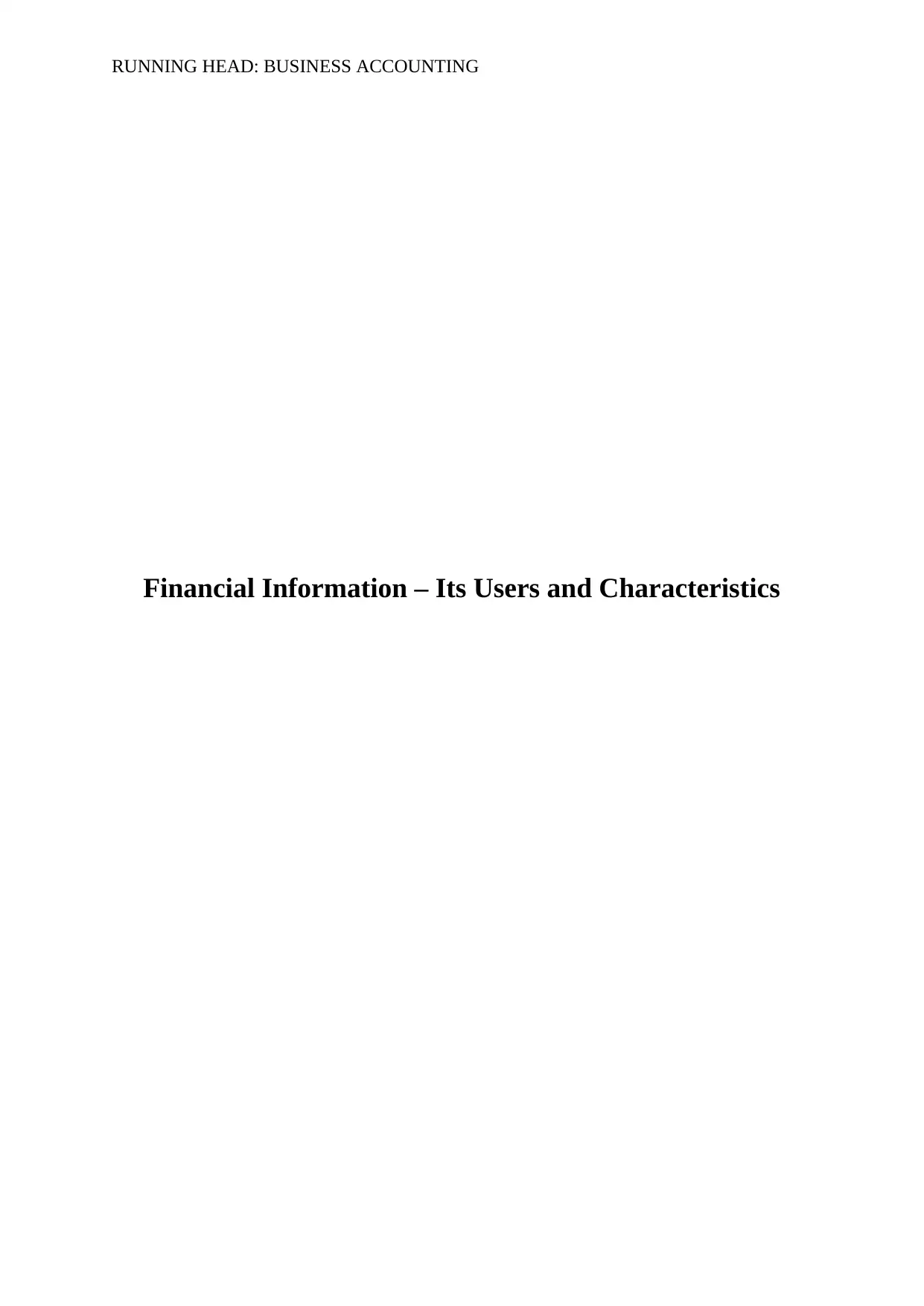
RUNNING HEAD: BUSINESS ACCOUNTING
Financial Information – Its Users and Characteristics
Financial Information – Its Users and Characteristics
Secure Best Marks with AI Grader
Need help grading? Try our AI Grader for instant feedback on your assignments.
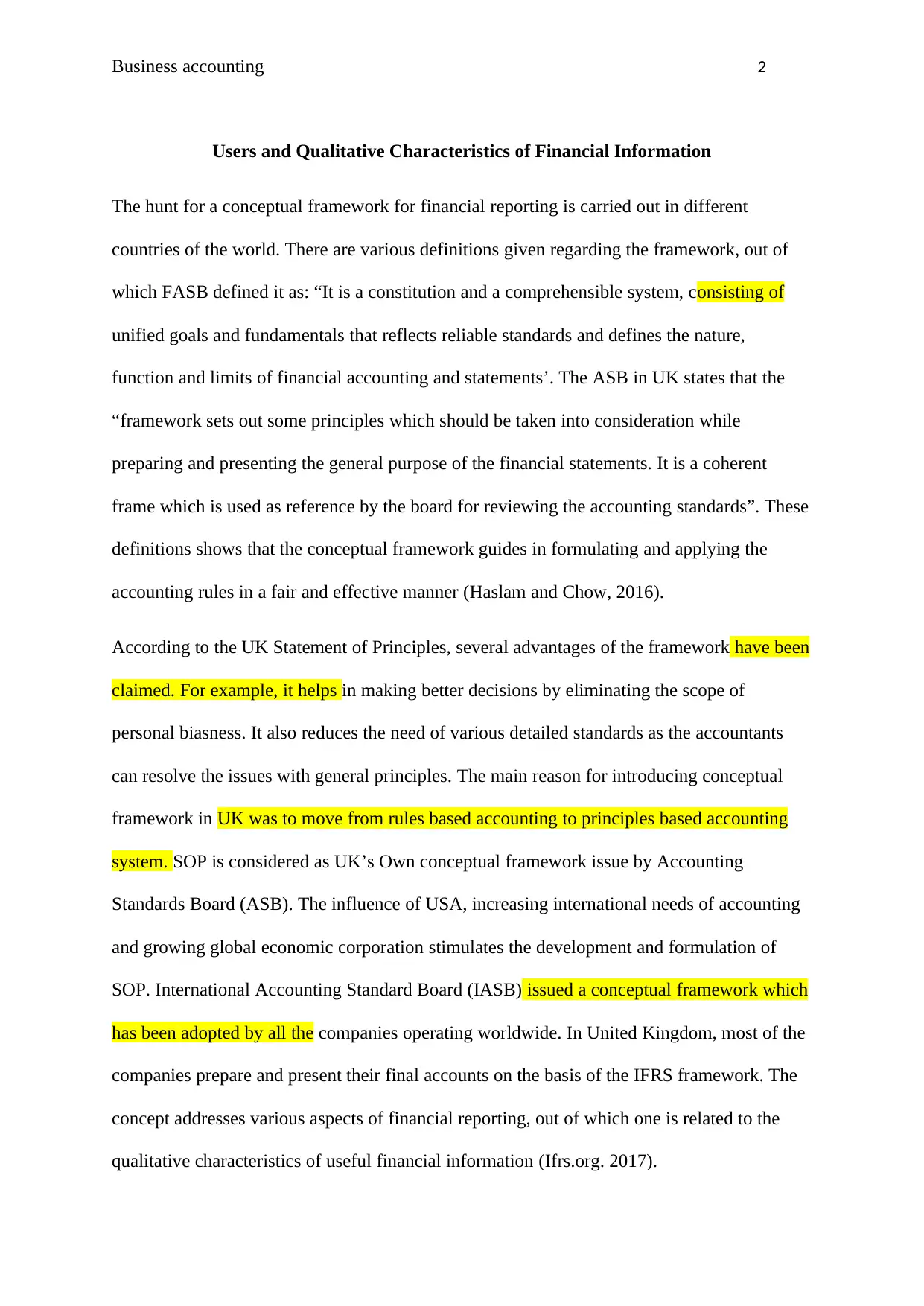
Business accounting 2
Users and Qualitative Characteristics of Financial Information
The hunt for a conceptual framework for financial reporting is carried out in different
countries of the world. There are various definitions given regarding the framework, out of
which FASB defined it as: “It is a constitution and a comprehensible system, consisting of
unified goals and fundamentals that reflects reliable standards and defines the nature,
function and limits of financial accounting and statements’. The ASB in UK states that the
“framework sets out some principles which should be taken into consideration while
preparing and presenting the general purpose of the financial statements. It is a coherent
frame which is used as reference by the board for reviewing the accounting standards”. These
definitions shows that the conceptual framework guides in formulating and applying the
accounting rules in a fair and effective manner (Haslam and Chow, 2016).
According to the UK Statement of Principles, several advantages of the framework have been
claimed. For example, it helps in making better decisions by eliminating the scope of
personal biasness. It also reduces the need of various detailed standards as the accountants
can resolve the issues with general principles. The main reason for introducing conceptual
framework in UK was to move from rules based accounting to principles based accounting
system. SOP is considered as UK’s Own conceptual framework issue by Accounting
Standards Board (ASB). The influence of USA, increasing international needs of accounting
and growing global economic corporation stimulates the development and formulation of
SOP. International Accounting Standard Board (IASB) issued a conceptual framework which
has been adopted by all the companies operating worldwide. In United Kingdom, most of the
companies prepare and present their final accounts on the basis of the IFRS framework. The
concept addresses various aspects of financial reporting, out of which one is related to the
qualitative characteristics of useful financial information (Ifrs.org. 2017).
Users and Qualitative Characteristics of Financial Information
The hunt for a conceptual framework for financial reporting is carried out in different
countries of the world. There are various definitions given regarding the framework, out of
which FASB defined it as: “It is a constitution and a comprehensible system, consisting of
unified goals and fundamentals that reflects reliable standards and defines the nature,
function and limits of financial accounting and statements’. The ASB in UK states that the
“framework sets out some principles which should be taken into consideration while
preparing and presenting the general purpose of the financial statements. It is a coherent
frame which is used as reference by the board for reviewing the accounting standards”. These
definitions shows that the conceptual framework guides in formulating and applying the
accounting rules in a fair and effective manner (Haslam and Chow, 2016).
According to the UK Statement of Principles, several advantages of the framework have been
claimed. For example, it helps in making better decisions by eliminating the scope of
personal biasness. It also reduces the need of various detailed standards as the accountants
can resolve the issues with general principles. The main reason for introducing conceptual
framework in UK was to move from rules based accounting to principles based accounting
system. SOP is considered as UK’s Own conceptual framework issue by Accounting
Standards Board (ASB). The influence of USA, increasing international needs of accounting
and growing global economic corporation stimulates the development and formulation of
SOP. International Accounting Standard Board (IASB) issued a conceptual framework which
has been adopted by all the companies operating worldwide. In United Kingdom, most of the
companies prepare and present their final accounts on the basis of the IFRS framework. The
concept addresses various aspects of financial reporting, out of which one is related to the
qualitative characteristics of useful financial information (Ifrs.org. 2017).
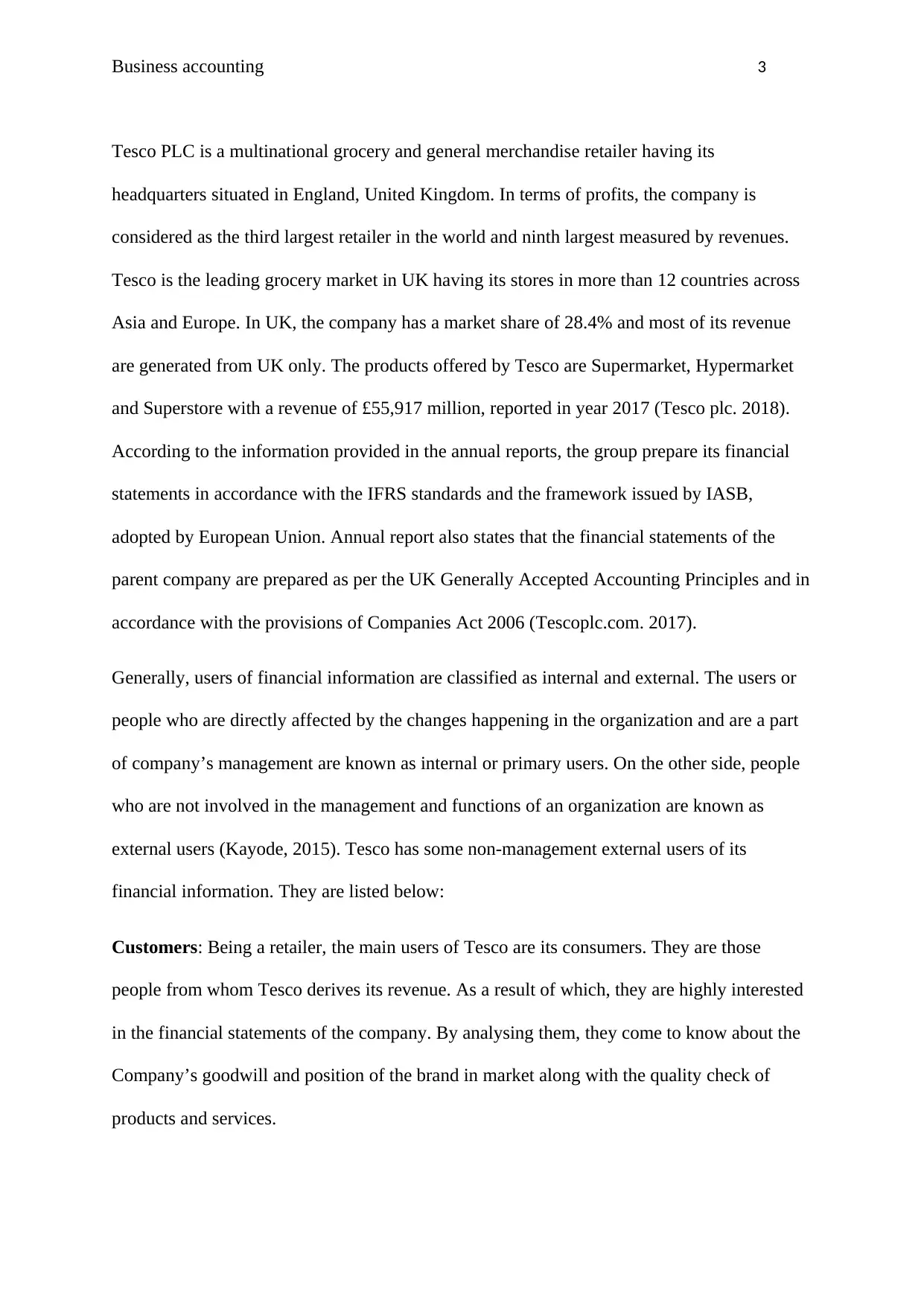
Business accounting 3
Tesco PLC is a multinational grocery and general merchandise retailer having its
headquarters situated in England, United Kingdom. In terms of profits, the company is
considered as the third largest retailer in the world and ninth largest measured by revenues.
Tesco is the leading grocery market in UK having its stores in more than 12 countries across
Asia and Europe. In UK, the company has a market share of 28.4% and most of its revenue
are generated from UK only. The products offered by Tesco are Supermarket, Hypermarket
and Superstore with a revenue of £55,917 million, reported in year 2017 (Tesco plc. 2018).
According to the information provided in the annual reports, the group prepare its financial
statements in accordance with the IFRS standards and the framework issued by IASB,
adopted by European Union. Annual report also states that the financial statements of the
parent company are prepared as per the UK Generally Accepted Accounting Principles and in
accordance with the provisions of Companies Act 2006 (Tescoplc.com. 2017).
Generally, users of financial information are classified as internal and external. The users or
people who are directly affected by the changes happening in the organization and are a part
of company’s management are known as internal or primary users. On the other side, people
who are not involved in the management and functions of an organization are known as
external users (Kayode, 2015). Tesco has some non-management external users of its
financial information. They are listed below:
Customers: Being a retailer, the main users of Tesco are its consumers. They are those
people from whom Tesco derives its revenue. As a result of which, they are highly interested
in the financial statements of the company. By analysing them, they come to know about the
Company’s goodwill and position of the brand in market along with the quality check of
products and services.
Tesco PLC is a multinational grocery and general merchandise retailer having its
headquarters situated in England, United Kingdom. In terms of profits, the company is
considered as the third largest retailer in the world and ninth largest measured by revenues.
Tesco is the leading grocery market in UK having its stores in more than 12 countries across
Asia and Europe. In UK, the company has a market share of 28.4% and most of its revenue
are generated from UK only. The products offered by Tesco are Supermarket, Hypermarket
and Superstore with a revenue of £55,917 million, reported in year 2017 (Tesco plc. 2018).
According to the information provided in the annual reports, the group prepare its financial
statements in accordance with the IFRS standards and the framework issued by IASB,
adopted by European Union. Annual report also states that the financial statements of the
parent company are prepared as per the UK Generally Accepted Accounting Principles and in
accordance with the provisions of Companies Act 2006 (Tescoplc.com. 2017).
Generally, users of financial information are classified as internal and external. The users or
people who are directly affected by the changes happening in the organization and are a part
of company’s management are known as internal or primary users. On the other side, people
who are not involved in the management and functions of an organization are known as
external users (Kayode, 2015). Tesco has some non-management external users of its
financial information. They are listed below:
Customers: Being a retailer, the main users of Tesco are its consumers. They are those
people from whom Tesco derives its revenue. As a result of which, they are highly interested
in the financial statements of the company. By analysing them, they come to know about the
Company’s goodwill and position of the brand in market along with the quality check of
products and services.
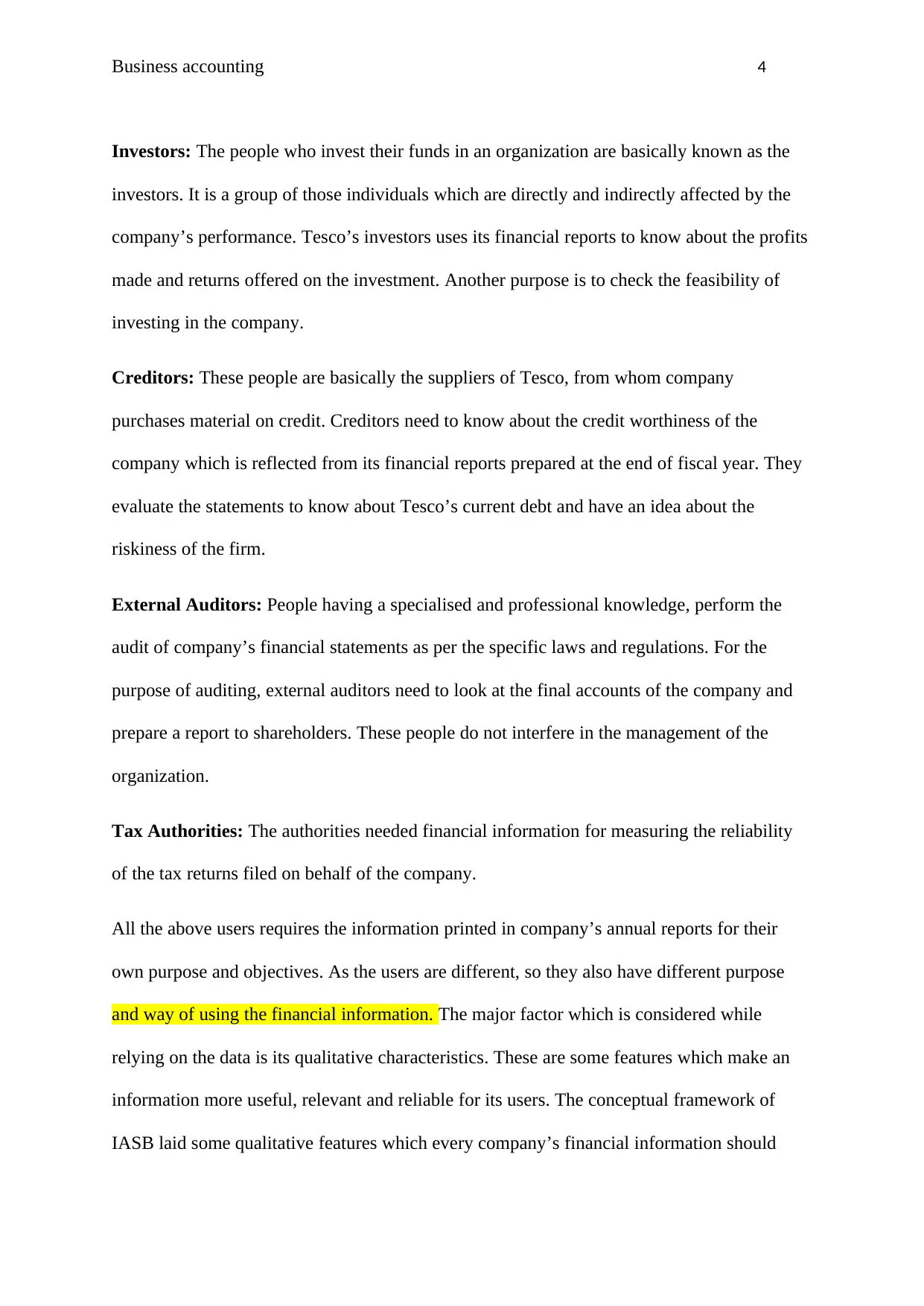
Business accounting 4
Investors: The people who invest their funds in an organization are basically known as the
investors. It is a group of those individuals which are directly and indirectly affected by the
company’s performance. Tesco’s investors uses its financial reports to know about the profits
made and returns offered on the investment. Another purpose is to check the feasibility of
investing in the company.
Creditors: These people are basically the suppliers of Tesco, from whom company
purchases material on credit. Creditors need to know about the credit worthiness of the
company which is reflected from its financial reports prepared at the end of fiscal year. They
evaluate the statements to know about Tesco’s current debt and have an idea about the
riskiness of the firm.
External Auditors: People having a specialised and professional knowledge, perform the
audit of company’s financial statements as per the specific laws and regulations. For the
purpose of auditing, external auditors need to look at the final accounts of the company and
prepare a report to shareholders. These people do not interfere in the management of the
organization.
Tax Authorities: The authorities needed financial information for measuring the reliability
of the tax returns filed on behalf of the company.
All the above users requires the information printed in company’s annual reports for their
own purpose and objectives. As the users are different, so they also have different purpose
and way of using the financial information. The major factor which is considered while
relying on the data is its qualitative characteristics. These are some features which make an
information more useful, relevant and reliable for its users. The conceptual framework of
IASB laid some qualitative features which every company’s financial information should
Investors: The people who invest their funds in an organization are basically known as the
investors. It is a group of those individuals which are directly and indirectly affected by the
company’s performance. Tesco’s investors uses its financial reports to know about the profits
made and returns offered on the investment. Another purpose is to check the feasibility of
investing in the company.
Creditors: These people are basically the suppliers of Tesco, from whom company
purchases material on credit. Creditors need to know about the credit worthiness of the
company which is reflected from its financial reports prepared at the end of fiscal year. They
evaluate the statements to know about Tesco’s current debt and have an idea about the
riskiness of the firm.
External Auditors: People having a specialised and professional knowledge, perform the
audit of company’s financial statements as per the specific laws and regulations. For the
purpose of auditing, external auditors need to look at the final accounts of the company and
prepare a report to shareholders. These people do not interfere in the management of the
organization.
Tax Authorities: The authorities needed financial information for measuring the reliability
of the tax returns filed on behalf of the company.
All the above users requires the information printed in company’s annual reports for their
own purpose and objectives. As the users are different, so they also have different purpose
and way of using the financial information. The major factor which is considered while
relying on the data is its qualitative characteristics. These are some features which make an
information more useful, relevant and reliable for its users. The conceptual framework of
IASB laid some qualitative features which every company’s financial information should
Secure Best Marks with AI Grader
Need help grading? Try our AI Grader for instant feedback on your assignments.
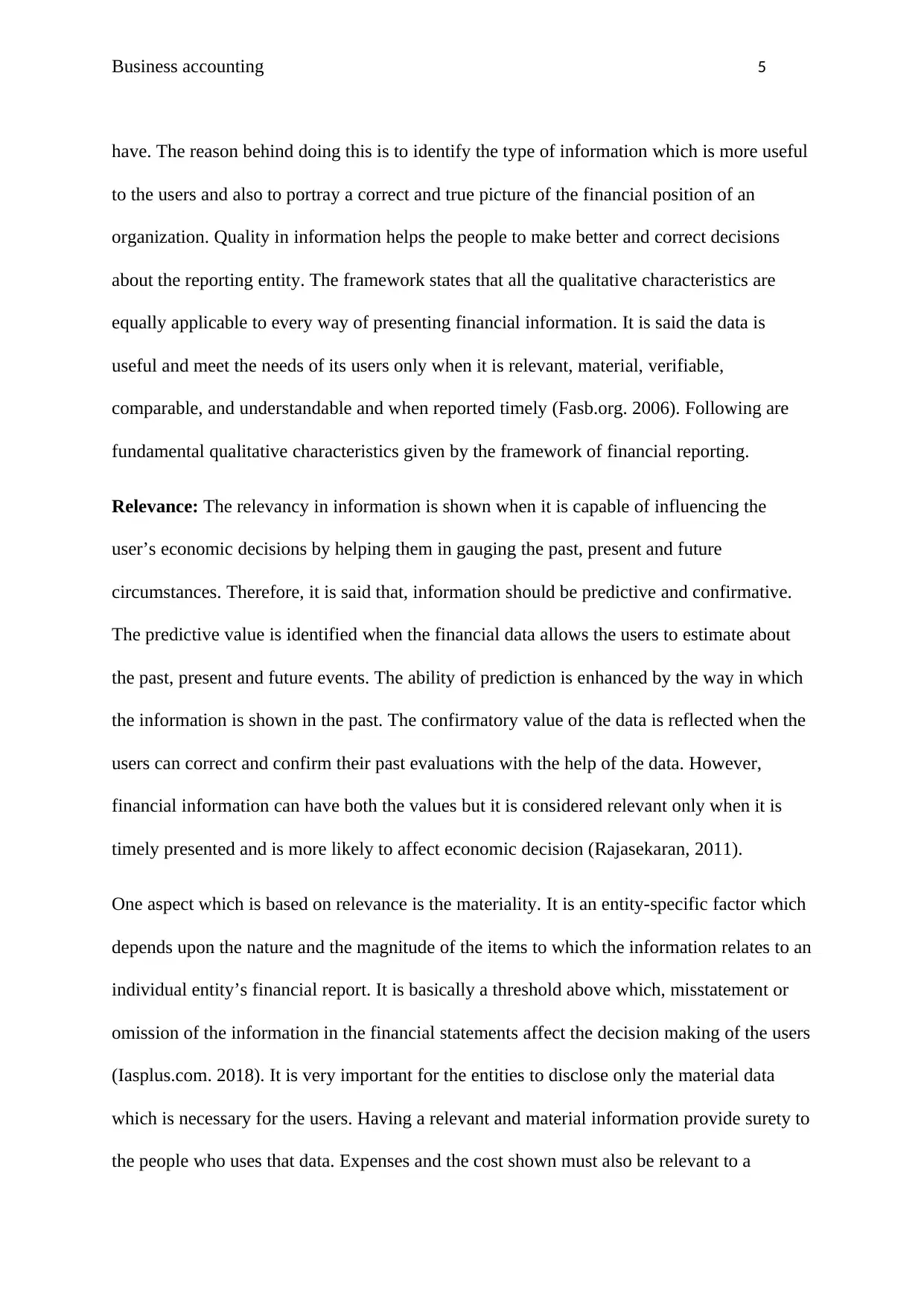
Business accounting 5
have. The reason behind doing this is to identify the type of information which is more useful
to the users and also to portray a correct and true picture of the financial position of an
organization. Quality in information helps the people to make better and correct decisions
about the reporting entity. The framework states that all the qualitative characteristics are
equally applicable to every way of presenting financial information. It is said the data is
useful and meet the needs of its users only when it is relevant, material, verifiable,
comparable, and understandable and when reported timely (Fasb.org. 2006). Following are
fundamental qualitative characteristics given by the framework of financial reporting.
Relevance: The relevancy in information is shown when it is capable of influencing the
user’s economic decisions by helping them in gauging the past, present and future
circumstances. Therefore, it is said that, information should be predictive and confirmative.
The predictive value is identified when the financial data allows the users to estimate about
the past, present and future events. The ability of prediction is enhanced by the way in which
the information is shown in the past. The confirmatory value of the data is reflected when the
users can correct and confirm their past evaluations with the help of the data. However,
financial information can have both the values but it is considered relevant only when it is
timely presented and is more likely to affect economic decision (Rajasekaran, 2011).
One aspect which is based on relevance is the materiality. It is an entity-specific factor which
depends upon the nature and the magnitude of the items to which the information relates to an
individual entity’s financial report. It is basically a threshold above which, misstatement or
omission of the information in the financial statements affect the decision making of the users
(Iasplus.com. 2018). It is very important for the entities to disclose only the material data
which is necessary for the users. Having a relevant and material information provide surety to
the people who uses that data. Expenses and the cost shown must also be relevant to a
have. The reason behind doing this is to identify the type of information which is more useful
to the users and also to portray a correct and true picture of the financial position of an
organization. Quality in information helps the people to make better and correct decisions
about the reporting entity. The framework states that all the qualitative characteristics are
equally applicable to every way of presenting financial information. It is said the data is
useful and meet the needs of its users only when it is relevant, material, verifiable,
comparable, and understandable and when reported timely (Fasb.org. 2006). Following are
fundamental qualitative characteristics given by the framework of financial reporting.
Relevance: The relevancy in information is shown when it is capable of influencing the
user’s economic decisions by helping them in gauging the past, present and future
circumstances. Therefore, it is said that, information should be predictive and confirmative.
The predictive value is identified when the financial data allows the users to estimate about
the past, present and future events. The ability of prediction is enhanced by the way in which
the information is shown in the past. The confirmatory value of the data is reflected when the
users can correct and confirm their past evaluations with the help of the data. However,
financial information can have both the values but it is considered relevant only when it is
timely presented and is more likely to affect economic decision (Rajasekaran, 2011).
One aspect which is based on relevance is the materiality. It is an entity-specific factor which
depends upon the nature and the magnitude of the items to which the information relates to an
individual entity’s financial report. It is basically a threshold above which, misstatement or
omission of the information in the financial statements affect the decision making of the users
(Iasplus.com. 2018). It is very important for the entities to disclose only the material data
which is necessary for the users. Having a relevant and material information provide surety to
the people who uses that data. Expenses and the cost shown must also be relevant to a
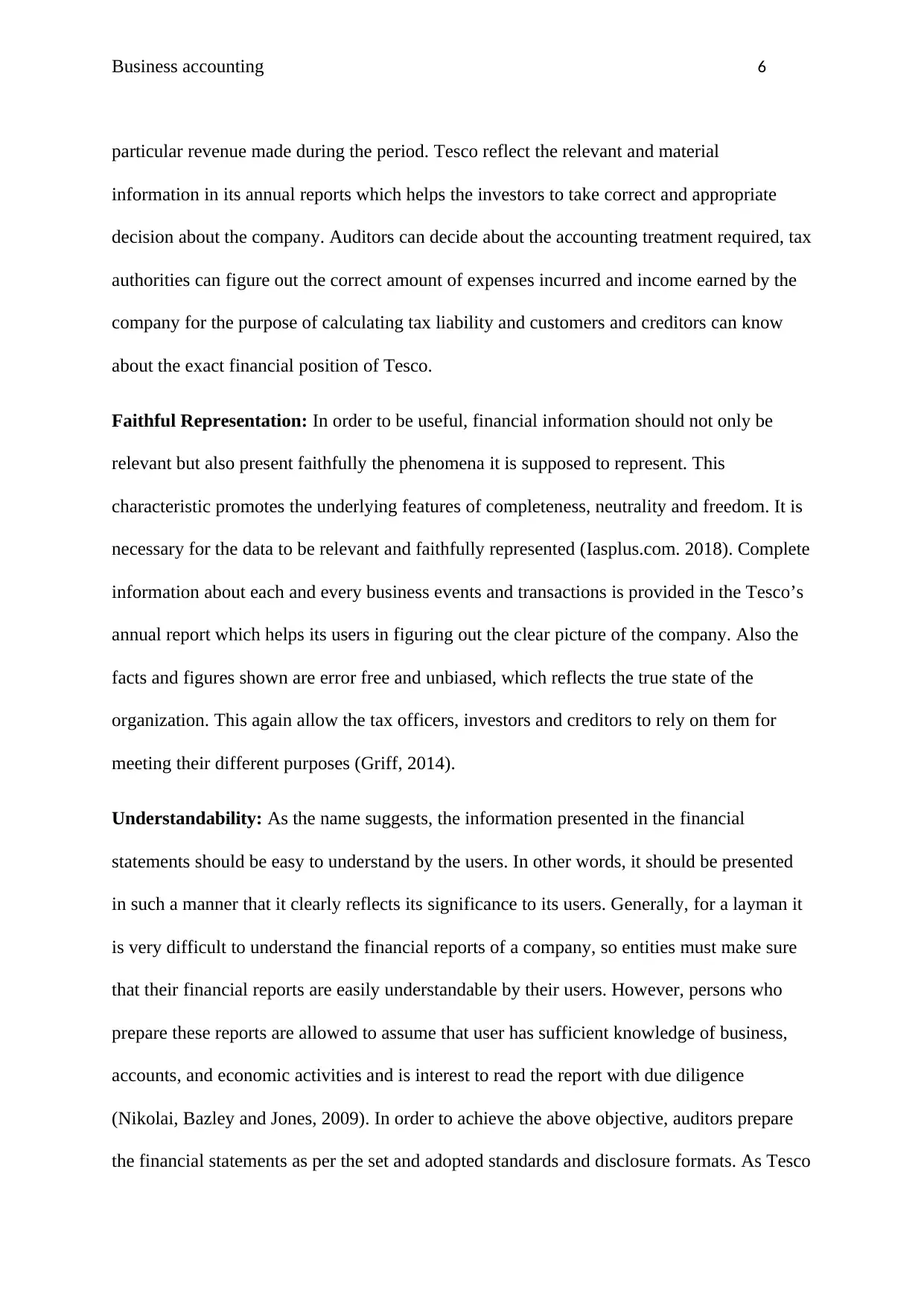
Business accounting 6
particular revenue made during the period. Tesco reflect the relevant and material
information in its annual reports which helps the investors to take correct and appropriate
decision about the company. Auditors can decide about the accounting treatment required, tax
authorities can figure out the correct amount of expenses incurred and income earned by the
company for the purpose of calculating tax liability and customers and creditors can know
about the exact financial position of Tesco.
Faithful Representation: In order to be useful, financial information should not only be
relevant but also present faithfully the phenomena it is supposed to represent. This
characteristic promotes the underlying features of completeness, neutrality and freedom. It is
necessary for the data to be relevant and faithfully represented (Iasplus.com. 2018). Complete
information about each and every business events and transactions is provided in the Tesco’s
annual report which helps its users in figuring out the clear picture of the company. Also the
facts and figures shown are error free and unbiased, which reflects the true state of the
organization. This again allow the tax officers, investors and creditors to rely on them for
meeting their different purposes (Griff, 2014).
Understandability: As the name suggests, the information presented in the financial
statements should be easy to understand by the users. In other words, it should be presented
in such a manner that it clearly reflects its significance to its users. Generally, for a layman it
is very difficult to understand the financial reports of a company, so entities must make sure
that their financial reports are easily understandable by their users. However, persons who
prepare these reports are allowed to assume that user has sufficient knowledge of business,
accounts, and economic activities and is interest to read the report with due diligence
(Nikolai, Bazley and Jones, 2009). In order to achieve the above objective, auditors prepare
the financial statements as per the set and adopted standards and disclosure formats. As Tesco
particular revenue made during the period. Tesco reflect the relevant and material
information in its annual reports which helps the investors to take correct and appropriate
decision about the company. Auditors can decide about the accounting treatment required, tax
authorities can figure out the correct amount of expenses incurred and income earned by the
company for the purpose of calculating tax liability and customers and creditors can know
about the exact financial position of Tesco.
Faithful Representation: In order to be useful, financial information should not only be
relevant but also present faithfully the phenomena it is supposed to represent. This
characteristic promotes the underlying features of completeness, neutrality and freedom. It is
necessary for the data to be relevant and faithfully represented (Iasplus.com. 2018). Complete
information about each and every business events and transactions is provided in the Tesco’s
annual report which helps its users in figuring out the clear picture of the company. Also the
facts and figures shown are error free and unbiased, which reflects the true state of the
organization. This again allow the tax officers, investors and creditors to rely on them for
meeting their different purposes (Griff, 2014).
Understandability: As the name suggests, the information presented in the financial
statements should be easy to understand by the users. In other words, it should be presented
in such a manner that it clearly reflects its significance to its users. Generally, for a layman it
is very difficult to understand the financial reports of a company, so entities must make sure
that their financial reports are easily understandable by their users. However, persons who
prepare these reports are allowed to assume that user has sufficient knowledge of business,
accounts, and economic activities and is interest to read the report with due diligence
(Nikolai, Bazley and Jones, 2009). In order to achieve the above objective, auditors prepare
the financial statements as per the set and adopted standards and disclosure formats. As Tesco
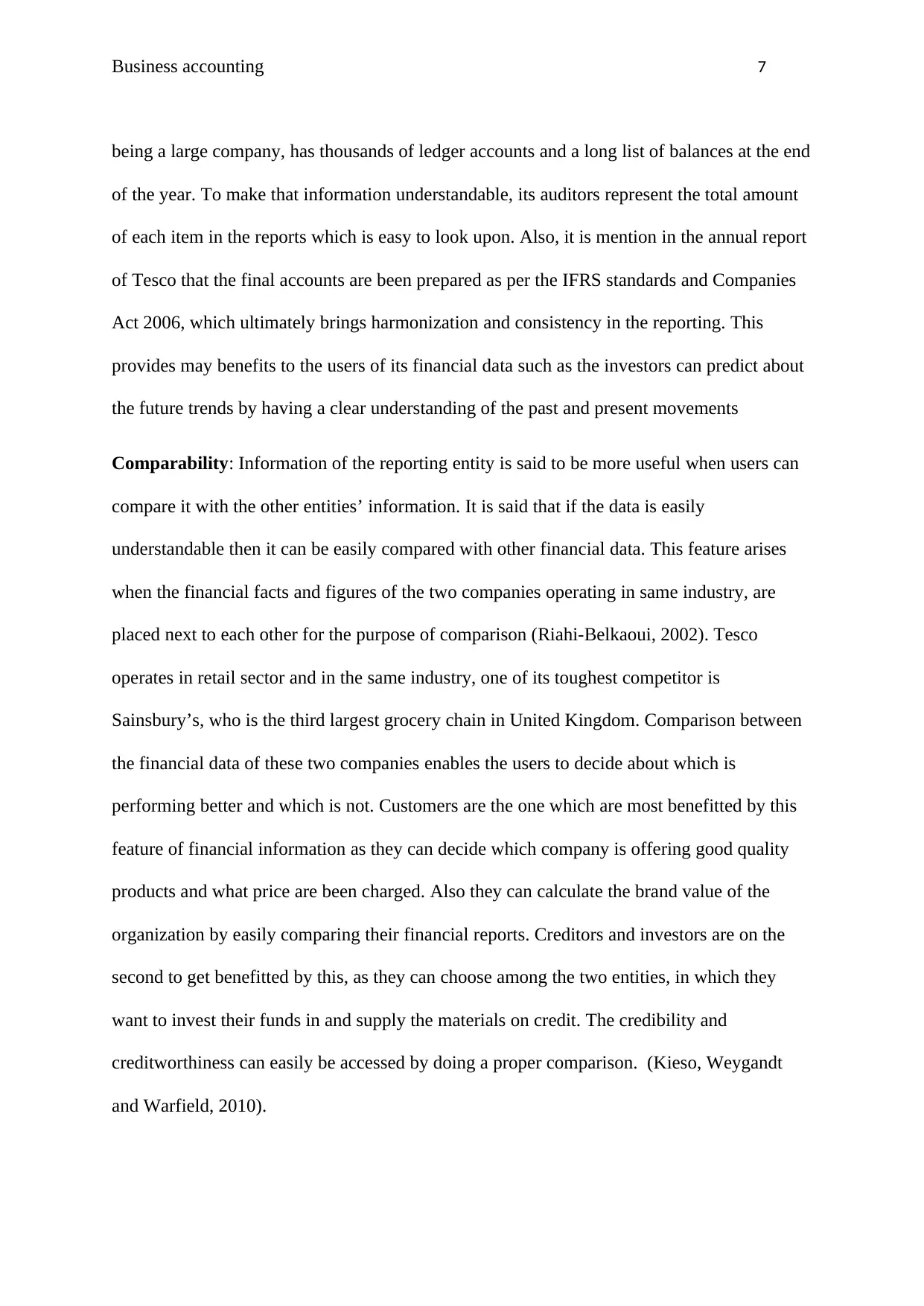
Business accounting 7
being a large company, has thousands of ledger accounts and a long list of balances at the end
of the year. To make that information understandable, its auditors represent the total amount
of each item in the reports which is easy to look upon. Also, it is mention in the annual report
of Tesco that the final accounts are been prepared as per the IFRS standards and Companies
Act 2006, which ultimately brings harmonization and consistency in the reporting. This
provides may benefits to the users of its financial data such as the investors can predict about
the future trends by having a clear understanding of the past and present movements
Comparability: Information of the reporting entity is said to be more useful when users can
compare it with the other entities’ information. It is said that if the data is easily
understandable then it can be easily compared with other financial data. This feature arises
when the financial facts and figures of the two companies operating in same industry, are
placed next to each other for the purpose of comparison (Riahi-Belkaoui, 2002). Tesco
operates in retail sector and in the same industry, one of its toughest competitor is
Sainsbury’s, who is the third largest grocery chain in United Kingdom. Comparison between
the financial data of these two companies enables the users to decide about which is
performing better and which is not. Customers are the one which are most benefitted by this
feature of financial information as they can decide which company is offering good quality
products and what price are been charged. Also they can calculate the brand value of the
organization by easily comparing their financial reports. Creditors and investors are on the
second to get benefitted by this, as they can choose among the two entities, in which they
want to invest their funds in and supply the materials on credit. The credibility and
creditworthiness can easily be accessed by doing a proper comparison. (Kieso, Weygandt
and Warfield, 2010).
being a large company, has thousands of ledger accounts and a long list of balances at the end
of the year. To make that information understandable, its auditors represent the total amount
of each item in the reports which is easy to look upon. Also, it is mention in the annual report
of Tesco that the final accounts are been prepared as per the IFRS standards and Companies
Act 2006, which ultimately brings harmonization and consistency in the reporting. This
provides may benefits to the users of its financial data such as the investors can predict about
the future trends by having a clear understanding of the past and present movements
Comparability: Information of the reporting entity is said to be more useful when users can
compare it with the other entities’ information. It is said that if the data is easily
understandable then it can be easily compared with other financial data. This feature arises
when the financial facts and figures of the two companies operating in same industry, are
placed next to each other for the purpose of comparison (Riahi-Belkaoui, 2002). Tesco
operates in retail sector and in the same industry, one of its toughest competitor is
Sainsbury’s, who is the third largest grocery chain in United Kingdom. Comparison between
the financial data of these two companies enables the users to decide about which is
performing better and which is not. Customers are the one which are most benefitted by this
feature of financial information as they can decide which company is offering good quality
products and what price are been charged. Also they can calculate the brand value of the
organization by easily comparing their financial reports. Creditors and investors are on the
second to get benefitted by this, as they can choose among the two entities, in which they
want to invest their funds in and supply the materials on credit. The credibility and
creditworthiness can easily be accessed by doing a proper comparison. (Kieso, Weygandt
and Warfield, 2010).
Paraphrase This Document
Need a fresh take? Get an instant paraphrase of this document with our AI Paraphraser
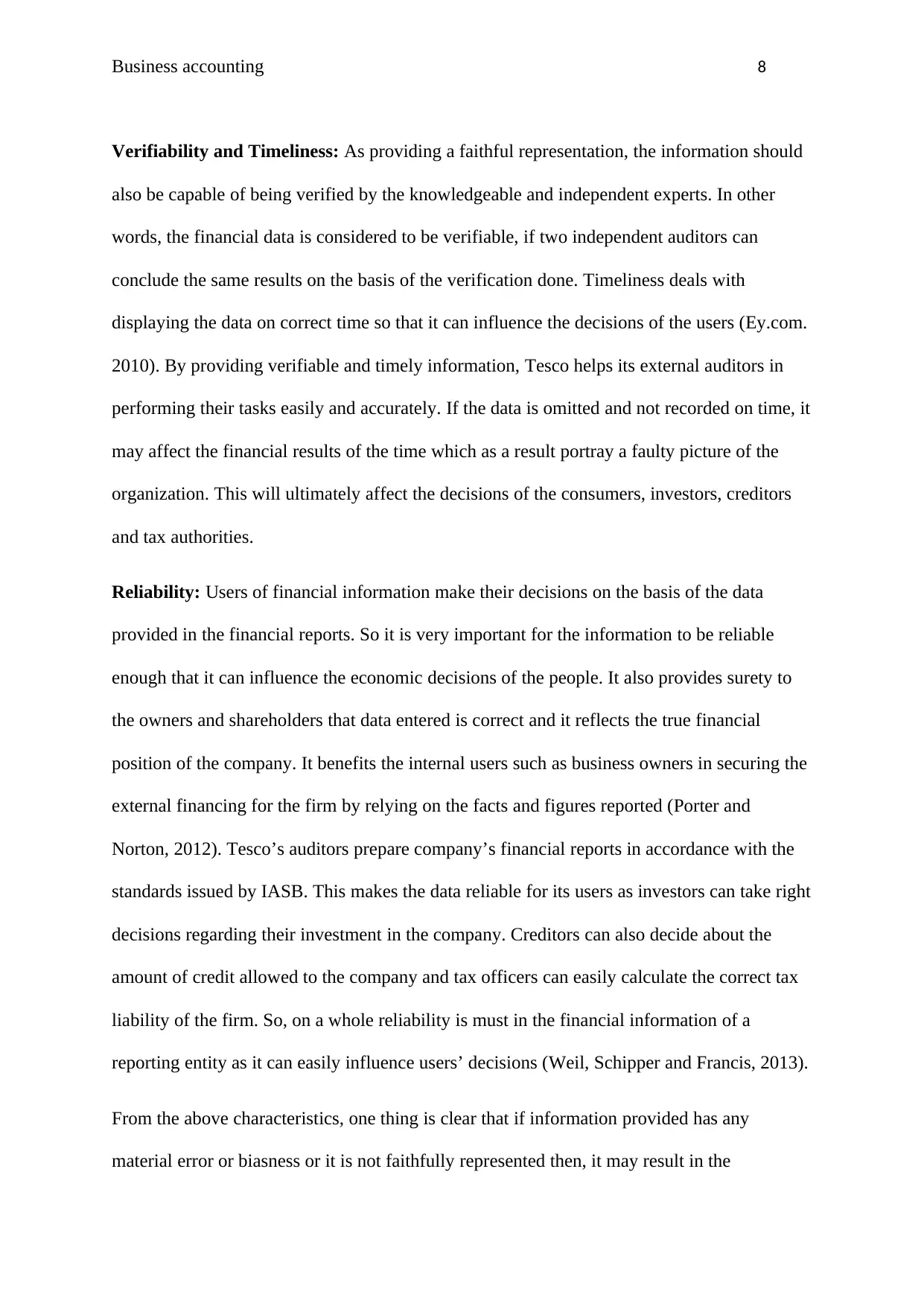
Business accounting 8
Verifiability and Timeliness: As providing a faithful representation, the information should
also be capable of being verified by the knowledgeable and independent experts. In other
words, the financial data is considered to be verifiable, if two independent auditors can
conclude the same results on the basis of the verification done. Timeliness deals with
displaying the data on correct time so that it can influence the decisions of the users (Ey.com.
2010). By providing verifiable and timely information, Tesco helps its external auditors in
performing their tasks easily and accurately. If the data is omitted and not recorded on time, it
may affect the financial results of the time which as a result portray a faulty picture of the
organization. This will ultimately affect the decisions of the consumers, investors, creditors
and tax authorities.
Reliability: Users of financial information make their decisions on the basis of the data
provided in the financial reports. So it is very important for the information to be reliable
enough that it can influence the economic decisions of the people. It also provides surety to
the owners and shareholders that data entered is correct and it reflects the true financial
position of the company. It benefits the internal users such as business owners in securing the
external financing for the firm by relying on the facts and figures reported (Porter and
Norton, 2012). Tesco’s auditors prepare company’s financial reports in accordance with the
standards issued by IASB. This makes the data reliable for its users as investors can take right
decisions regarding their investment in the company. Creditors can also decide about the
amount of credit allowed to the company and tax officers can easily calculate the correct tax
liability of the firm. So, on a whole reliability is must in the financial information of a
reporting entity as it can easily influence users’ decisions (Weil, Schipper and Francis, 2013).
From the above characteristics, one thing is clear that if information provided has any
material error or biasness or it is not faithfully represented then, it may result in the
Verifiability and Timeliness: As providing a faithful representation, the information should
also be capable of being verified by the knowledgeable and independent experts. In other
words, the financial data is considered to be verifiable, if two independent auditors can
conclude the same results on the basis of the verification done. Timeliness deals with
displaying the data on correct time so that it can influence the decisions of the users (Ey.com.
2010). By providing verifiable and timely information, Tesco helps its external auditors in
performing their tasks easily and accurately. If the data is omitted and not recorded on time, it
may affect the financial results of the time which as a result portray a faulty picture of the
organization. This will ultimately affect the decisions of the consumers, investors, creditors
and tax authorities.
Reliability: Users of financial information make their decisions on the basis of the data
provided in the financial reports. So it is very important for the information to be reliable
enough that it can influence the economic decisions of the people. It also provides surety to
the owners and shareholders that data entered is correct and it reflects the true financial
position of the company. It benefits the internal users such as business owners in securing the
external financing for the firm by relying on the facts and figures reported (Porter and
Norton, 2012). Tesco’s auditors prepare company’s financial reports in accordance with the
standards issued by IASB. This makes the data reliable for its users as investors can take right
decisions regarding their investment in the company. Creditors can also decide about the
amount of credit allowed to the company and tax officers can easily calculate the correct tax
liability of the firm. So, on a whole reliability is must in the financial information of a
reporting entity as it can easily influence users’ decisions (Weil, Schipper and Francis, 2013).
From the above characteristics, one thing is clear that if information provided has any
material error or biasness or it is not faithfully represented then, it may result in the
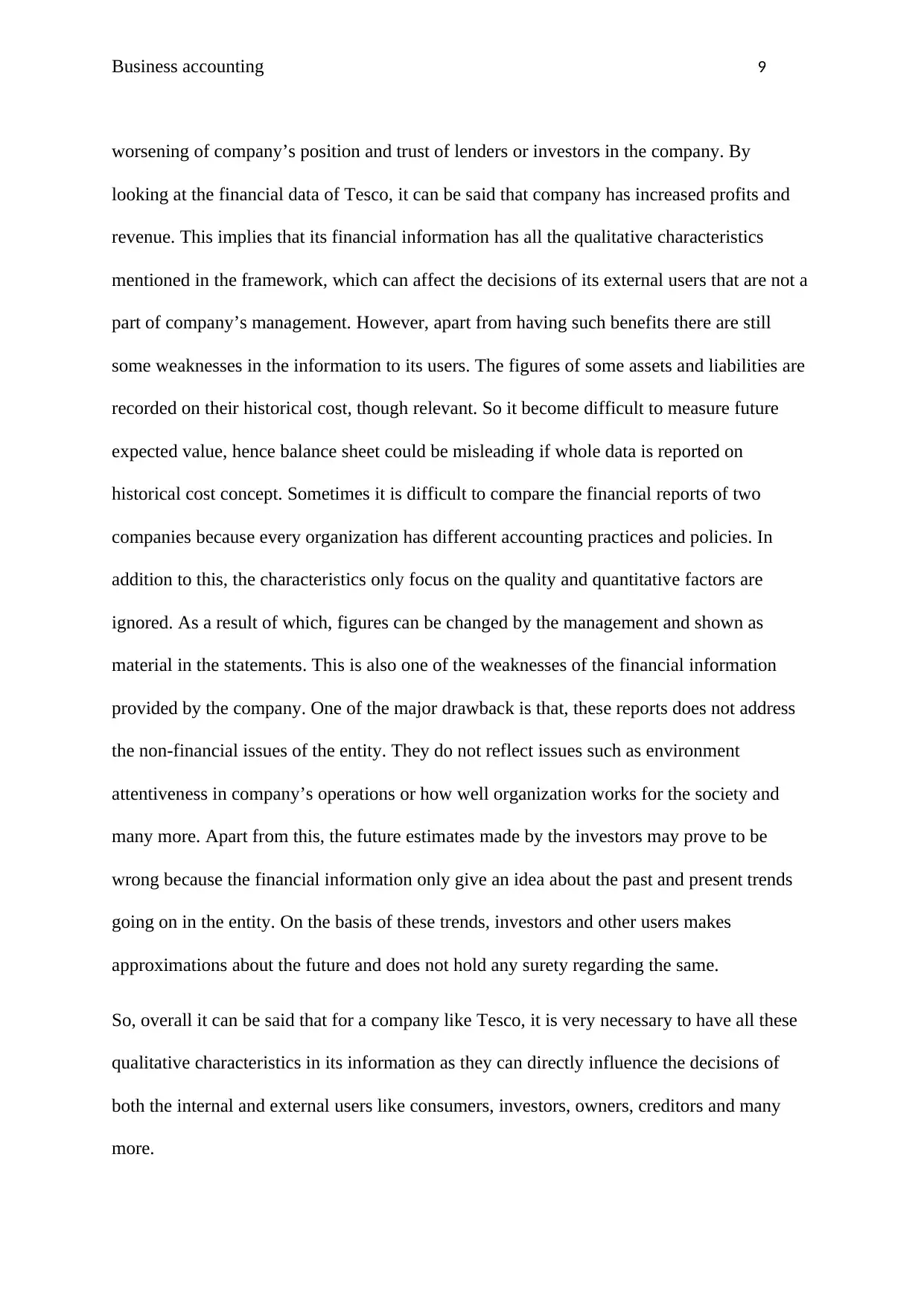
Business accounting 9
worsening of company’s position and trust of lenders or investors in the company. By
looking at the financial data of Tesco, it can be said that company has increased profits and
revenue. This implies that its financial information has all the qualitative characteristics
mentioned in the framework, which can affect the decisions of its external users that are not a
part of company’s management. However, apart from having such benefits there are still
some weaknesses in the information to its users. The figures of some assets and liabilities are
recorded on their historical cost, though relevant. So it become difficult to measure future
expected value, hence balance sheet could be misleading if whole data is reported on
historical cost concept. Sometimes it is difficult to compare the financial reports of two
companies because every organization has different accounting practices and policies. In
addition to this, the characteristics only focus on the quality and quantitative factors are
ignored. As a result of which, figures can be changed by the management and shown as
material in the statements. This is also one of the weaknesses of the financial information
provided by the company. One of the major drawback is that, these reports does not address
the non-financial issues of the entity. They do not reflect issues such as environment
attentiveness in company’s operations or how well organization works for the society and
many more. Apart from this, the future estimates made by the investors may prove to be
wrong because the financial information only give an idea about the past and present trends
going on in the entity. On the basis of these trends, investors and other users makes
approximations about the future and does not hold any surety regarding the same.
So, overall it can be said that for a company like Tesco, it is very necessary to have all these
qualitative characteristics in its information as they can directly influence the decisions of
both the internal and external users like consumers, investors, owners, creditors and many
more.
worsening of company’s position and trust of lenders or investors in the company. By
looking at the financial data of Tesco, it can be said that company has increased profits and
revenue. This implies that its financial information has all the qualitative characteristics
mentioned in the framework, which can affect the decisions of its external users that are not a
part of company’s management. However, apart from having such benefits there are still
some weaknesses in the information to its users. The figures of some assets and liabilities are
recorded on their historical cost, though relevant. So it become difficult to measure future
expected value, hence balance sheet could be misleading if whole data is reported on
historical cost concept. Sometimes it is difficult to compare the financial reports of two
companies because every organization has different accounting practices and policies. In
addition to this, the characteristics only focus on the quality and quantitative factors are
ignored. As a result of which, figures can be changed by the management and shown as
material in the statements. This is also one of the weaknesses of the financial information
provided by the company. One of the major drawback is that, these reports does not address
the non-financial issues of the entity. They do not reflect issues such as environment
attentiveness in company’s operations or how well organization works for the society and
many more. Apart from this, the future estimates made by the investors may prove to be
wrong because the financial information only give an idea about the past and present trends
going on in the entity. On the basis of these trends, investors and other users makes
approximations about the future and does not hold any surety regarding the same.
So, overall it can be said that for a company like Tesco, it is very necessary to have all these
qualitative characteristics in its information as they can directly influence the decisions of
both the internal and external users like consumers, investors, owners, creditors and many
more.
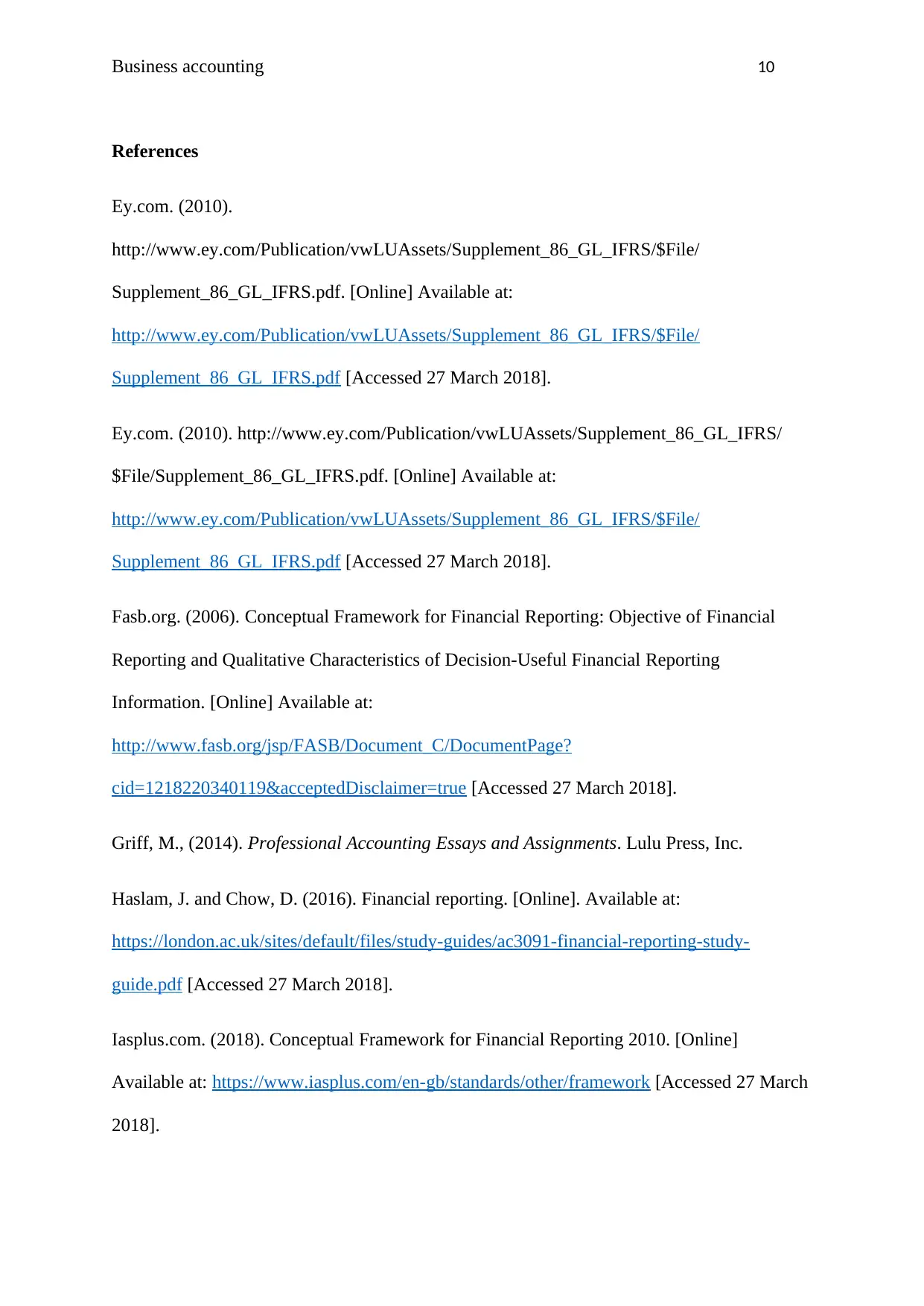
Business accounting 10
References
Ey.com. (2010).
http://www.ey.com/Publication/vwLUAssets/Supplement_86_GL_IFRS/$File/
Supplement_86_GL_IFRS.pdf. [Online] Available at:
http://www.ey.com/Publication/vwLUAssets/Supplement_86_GL_IFRS/$File/
Supplement_86_GL_IFRS.pdf [Accessed 27 March 2018].
Ey.com. (2010). http://www.ey.com/Publication/vwLUAssets/Supplement_86_GL_IFRS/
$File/Supplement_86_GL_IFRS.pdf. [Online] Available at:
http://www.ey.com/Publication/vwLUAssets/Supplement_86_GL_IFRS/$File/
Supplement_86_GL_IFRS.pdf [Accessed 27 March 2018].
Fasb.org. (2006). Conceptual Framework for Financial Reporting: Objective of Financial
Reporting and Qualitative Characteristics of Decision-Useful Financial Reporting
Information. [Online] Available at:
http://www.fasb.org/jsp/FASB/Document_C/DocumentPage?
cid=1218220340119&acceptedDisclaimer=true [Accessed 27 March 2018].
Griff, M., (2014). Professional Accounting Essays and Assignments. Lulu Press, Inc.
Haslam, J. and Chow, D. (2016). Financial reporting. [Online]. Available at:
https://london.ac.uk/sites/default/files/study-guides/ac3091-financial-reporting-study-
guide.pdf [Accessed 27 March 2018].
Iasplus.com. (2018). Conceptual Framework for Financial Reporting 2010. [Online]
Available at: https://www.iasplus.com/en-gb/standards/other/framework [Accessed 27 March
2018].
References
Ey.com. (2010).
http://www.ey.com/Publication/vwLUAssets/Supplement_86_GL_IFRS/$File/
Supplement_86_GL_IFRS.pdf. [Online] Available at:
http://www.ey.com/Publication/vwLUAssets/Supplement_86_GL_IFRS/$File/
Supplement_86_GL_IFRS.pdf [Accessed 27 March 2018].
Ey.com. (2010). http://www.ey.com/Publication/vwLUAssets/Supplement_86_GL_IFRS/
$File/Supplement_86_GL_IFRS.pdf. [Online] Available at:
http://www.ey.com/Publication/vwLUAssets/Supplement_86_GL_IFRS/$File/
Supplement_86_GL_IFRS.pdf [Accessed 27 March 2018].
Fasb.org. (2006). Conceptual Framework for Financial Reporting: Objective of Financial
Reporting and Qualitative Characteristics of Decision-Useful Financial Reporting
Information. [Online] Available at:
http://www.fasb.org/jsp/FASB/Document_C/DocumentPage?
cid=1218220340119&acceptedDisclaimer=true [Accessed 27 March 2018].
Griff, M., (2014). Professional Accounting Essays and Assignments. Lulu Press, Inc.
Haslam, J. and Chow, D. (2016). Financial reporting. [Online]. Available at:
https://london.ac.uk/sites/default/files/study-guides/ac3091-financial-reporting-study-
guide.pdf [Accessed 27 March 2018].
Iasplus.com. (2018). Conceptual Framework for Financial Reporting 2010. [Online]
Available at: https://www.iasplus.com/en-gb/standards/other/framework [Accessed 27 March
2018].
Secure Best Marks with AI Grader
Need help grading? Try our AI Grader for instant feedback on your assignments.
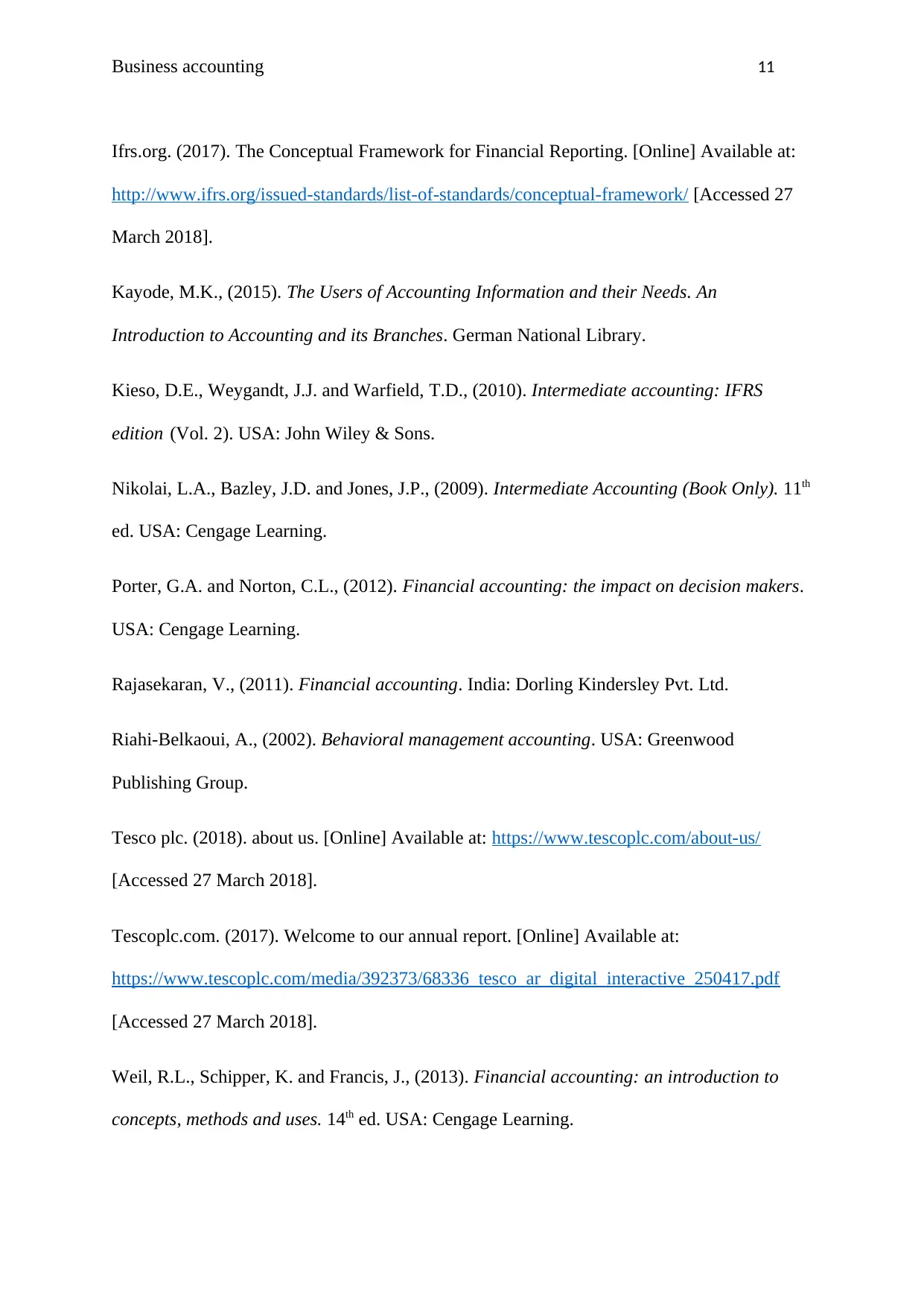
Business accounting 11
Ifrs.org. (2017). The Conceptual Framework for Financial Reporting. [Online] Available at:
http://www.ifrs.org/issued-standards/list-of-standards/conceptual-framework/ [Accessed 27
March 2018].
Kayode, M.K., (2015). The Users of Accounting Information and their Needs. An
Introduction to Accounting and its Branches. German National Library.
Kieso, D.E., Weygandt, J.J. and Warfield, T.D., (2010). Intermediate accounting: IFRS
edition (Vol. 2). USA: John Wiley & Sons.
Nikolai, L.A., Bazley, J.D. and Jones, J.P., (2009). Intermediate Accounting (Book Only). 11th
ed. USA: Cengage Learning.
Porter, G.A. and Norton, C.L., (2012). Financial accounting: the impact on decision makers.
USA: Cengage Learning.
Rajasekaran, V., (2011). Financial accounting. India: Dorling Kindersley Pvt. Ltd.
Riahi-Belkaoui, A., (2002). Behavioral management accounting. USA: Greenwood
Publishing Group.
Tesco plc. (2018). about us. [Online] Available at: https://www.tescoplc.com/about-us/
[Accessed 27 March 2018].
Tescoplc.com. (2017). Welcome to our annual report. [Online] Available at:
https://www.tescoplc.com/media/392373/68336_tesco_ar_digital_interactive_250417.pdf
[Accessed 27 March 2018].
Weil, R.L., Schipper, K. and Francis, J., (2013). Financial accounting: an introduction to
concepts, methods and uses. 14th ed. USA: Cengage Learning.
Ifrs.org. (2017). The Conceptual Framework for Financial Reporting. [Online] Available at:
http://www.ifrs.org/issued-standards/list-of-standards/conceptual-framework/ [Accessed 27
March 2018].
Kayode, M.K., (2015). The Users of Accounting Information and their Needs. An
Introduction to Accounting and its Branches. German National Library.
Kieso, D.E., Weygandt, J.J. and Warfield, T.D., (2010). Intermediate accounting: IFRS
edition (Vol. 2). USA: John Wiley & Sons.
Nikolai, L.A., Bazley, J.D. and Jones, J.P., (2009). Intermediate Accounting (Book Only). 11th
ed. USA: Cengage Learning.
Porter, G.A. and Norton, C.L., (2012). Financial accounting: the impact on decision makers.
USA: Cengage Learning.
Rajasekaran, V., (2011). Financial accounting. India: Dorling Kindersley Pvt. Ltd.
Riahi-Belkaoui, A., (2002). Behavioral management accounting. USA: Greenwood
Publishing Group.
Tesco plc. (2018). about us. [Online] Available at: https://www.tescoplc.com/about-us/
[Accessed 27 March 2018].
Tescoplc.com. (2017). Welcome to our annual report. [Online] Available at:
https://www.tescoplc.com/media/392373/68336_tesco_ar_digital_interactive_250417.pdf
[Accessed 27 March 2018].
Weil, R.L., Schipper, K. and Francis, J., (2013). Financial accounting: an introduction to
concepts, methods and uses. 14th ed. USA: Cengage Learning.
1 out of 11
Related Documents
Your All-in-One AI-Powered Toolkit for Academic Success.
+13062052269
info@desklib.com
Available 24*7 on WhatsApp / Email
![[object Object]](/_next/static/media/star-bottom.7253800d.svg)
Unlock your academic potential
© 2024 | Zucol Services PVT LTD | All rights reserved.




